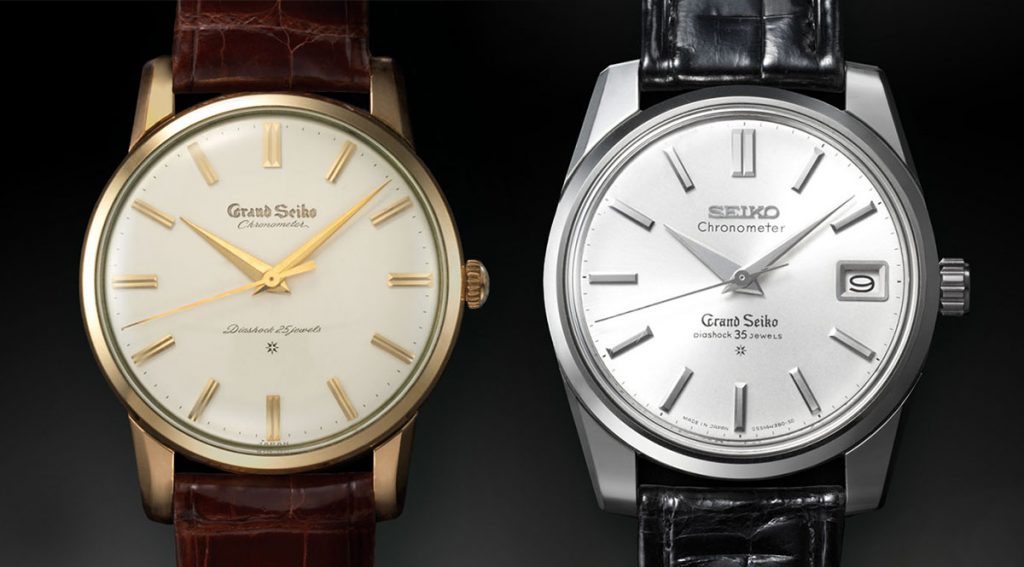
The 57GS, developed by Suwa Seikosha, is the first family of Grand Seiko watches, introduced in late 1960 with the Grand Seiko Chronometer, commonly known nowadays as the Grand Seiko First.
The Grand Seiko 57GS family consists of the following movements:
- Caliber 3180, later renamed 5720A, was accurate to within +12 to -3 seconds a day, running at 18,000 bph with 45 hours of power reserve
- Caliber 430, later renamed 5722A, also running at 18,000 bph with 45 hours of power reserve, introduced the first date complication in a Grand Seiko watch
- Caliber 5722B, an improved version of the 5722A, running at 19,800 bph for increased accuracy
When Seiko renamed their movements in the mid 1960s, caliber 3180 was already out of production. For this reason, even though its name was changed to 5720A, all existing examples bear the inscription 3180.
On the other hand, for the 430 caliber, the latest examples produced bear the inscription 5720A.
The Grand Seiko Chronometer
Introduced in Japan on December 18 of 1960, it was the first Japanese watch to pass the rating of the Bureaux Officiels de Contrôle de la Marche des Montres. Seiko’s goal was to create the ideal watch, according to the highest standards of precision, beauty, legibility and durability.

Manufactured by Suwa Seikosha, it housed the caliber 3180 (later renamed 5720A), which combined some characteristics of the movements previously developed by Seiko for the Lord Marvel and the Crown.
The manual winding movement, running at 18,000 bph with 45 hours of power reserve, has 25 jewels and it was regulated to be accurate within +12 to -3 seconds a day.
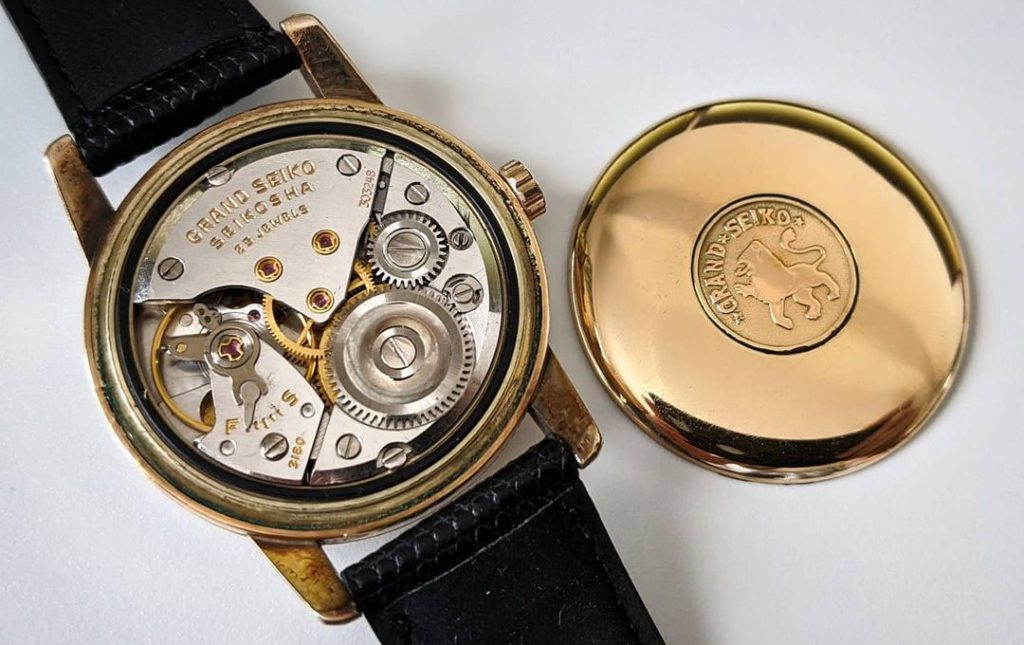
Most of the examples produced feature a case coated with a layer of 14-karat gold that is 80 microns thick (considerably thicker than common gold plating). Some examples with platinum cases were also produced, much rarer and more expensive than the previous ones. The latter are not present in the catalogs of the time, but their existence is officially confirmed by Seiko.
According to the official version, the first Grand Seiko was never produced with a steel case, and the specimens of this type that are occasionally seen on the second-hand market are almost certainly assembled watches, containing non-original or modified parts.

The price for a Grand Seiko Chronometer in the early 1960s was 25,000 yen for the gold filled version, while the much more exclusive platinum version was priced at 140,000 yen.
The Gothic font was chosen for the Grand Seiko logo, to express respect for the long history of mechanical watchmaking.
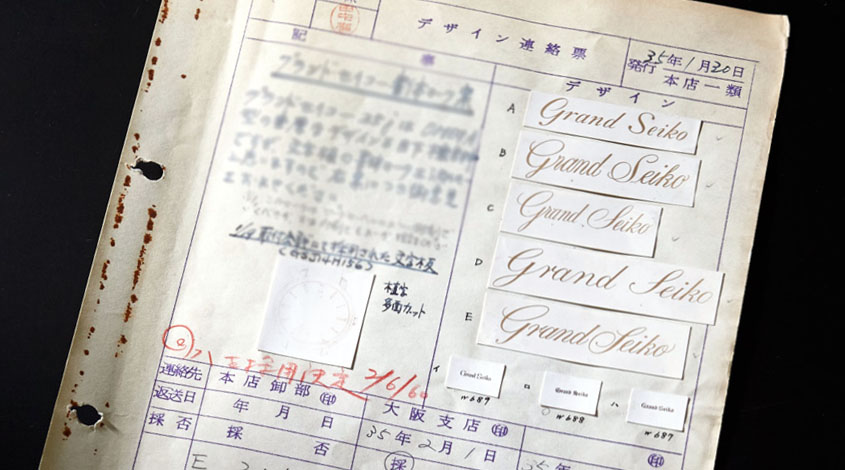
Dial variations of the Grand Seiko First
Both in the gold filled examples and in those in platinum, we find different variations of the dial. In some examples, particularly in the early ones, the Grand Seiko logo located at 12 o’clock is engraved or printed, while in others (most of them) the logo is raised.
Almost all of the specimens, both gold filled and platinum case, have dials of the SD type (Special Dial), as can be seen from the symbol at 6 o’clock, but there are rare examples of AD dials.


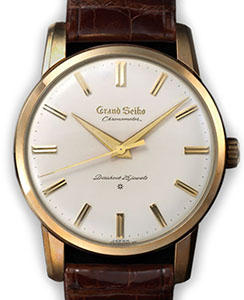
Ref. J14070 – Gold Filled
Movement: 3180
Type: manual
Jewels: 25
Bph: 18.000
Case: gold filled (14k gold, 80 micron)
Dial variations: SD, AD
Logo variations: engraved, printed, raised
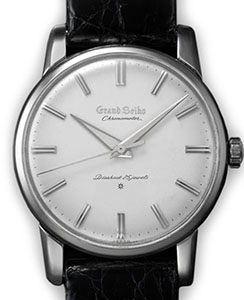
Ref. J14070 – Platinum
Movement: 3180
Type: manual
Jewels: 25
Bph: 18.000
Case: platinum
Dial variations: SD, AD
Logo variations: engraved, printed, raised
Grand Seiko Self-Dater/Calendar
Introduced in 1963, it was the first Grand Seiko with a date complication, equipped with Seiko’s proprietary fast-forward mechanism. The watch also guaranteed a water resistance of 50 meters (5 atm).
Additionally, the Self-Dater was the first Grand Seiko ever to feature a Zaratsu polishing on the case surface.
Caliber 5722A, initially called 430, runs at 18,000 bph, while the later 5722B improved version runs at 19,800 bph for greater accuracy.
There are two variants of the early model with reference 43999: one with SD dial (Special Dial), and another with AD dial (Applied Dial). The difference is that the indexes of the SD dial are made of solid white gold.

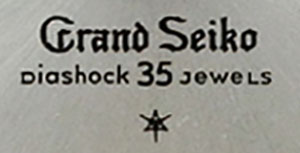

Ref. 43999 (SD)
Movement: 430
Type: manual
Jewels: 35
Case: stainless steel
First version of the Self Dater, with SD dial.

Ref. 43999 (AD)
Movement: 430
Type: manual
Jewels: 35
Case: stainless steel
First version of the Self Dater, with AD quadrant.
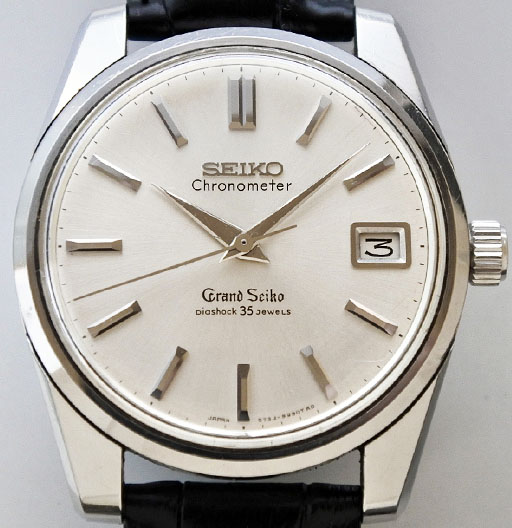
Ref. 5722-9990
Movement: 5722
Type: manual
Jewels: 35
Case: stainless steel
Model updated according to the new standards for Seiko case-movement references. “Chronometer” written on the dial.

Ref. 5722-9000
Movement: 5722
Type: manual
Jewels: 35
Case: 18k gold
Self Dater with solid gold case. “Chronometer” written on the dial.

Ref. 5722-9970
Movement: 5722
Type: manual
Jewels: 35
Case: stainless steel
Reference commissioned by Toshiba, for employees who had completed 25 years of work in the company. Recognizable by the writing on the back of the case, the 1965 and 1966 versions had the Chronometer writing under the Seiko logo, no longer present in the 1967 and 1968 versions.
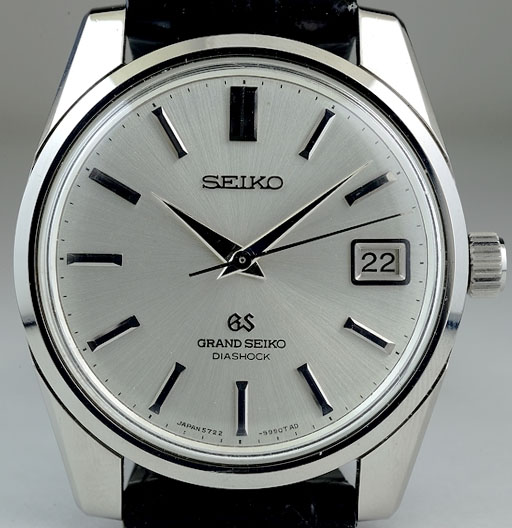
Ref. 5722-9991
Movement: 5722
Type: manual
Jewels: 35
Case: stainless steel
Chronometer writing no longer present.
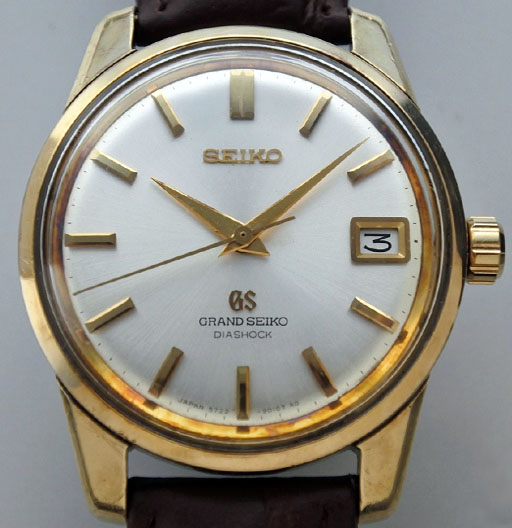
Ref. 5722-9010
Movement: 5722
Type: manual
Jewels: 35
Case: gold cap

Ref. 5722-9011
Movement: 5722
Type: manual
Jewels: 35
Case: gold cap
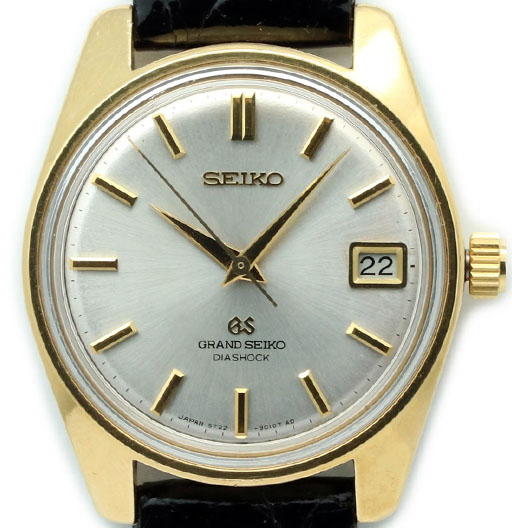
Ref. 5722-9001
Movement: 5722
Type: manual
Jewels: 35
Case: 18k gold
Self Dater with soilid gold case, Chronometer writing no longer present.
57GS Movements
Caliber 3180 (5720A)

Technical sheet: Japanese – English
| Type | Manual |
| Complications | – |
| Bph | 18,000 |
| Jewels | 25 |
| Accuracy | +12 to -3 seconds a day |
| Power reserve | 45 hours |
| Hacking | Yes |
Caliber 430 (5722A)

Technical sheet: Japanese
| Type | Manual |
| Complications | Date |
| Bph | 18,000 |
| Jewels | 35 |
| Hacking | Yes |
Caliber 5722B
Technical sheet: Japanese – English
| Type | Manual |
| Complications | Date |
| Bph | 19,800 |
| Jewels | 35 |
| Hacking | Yes |